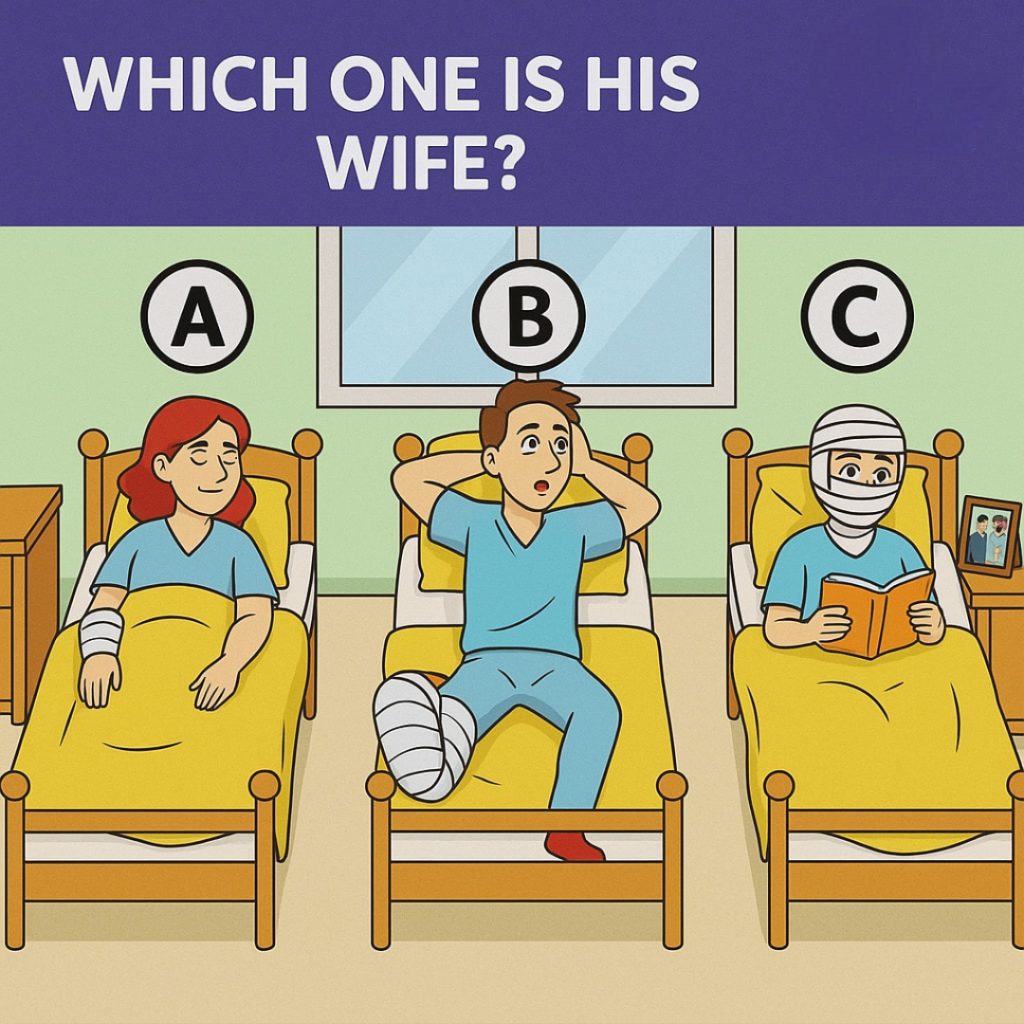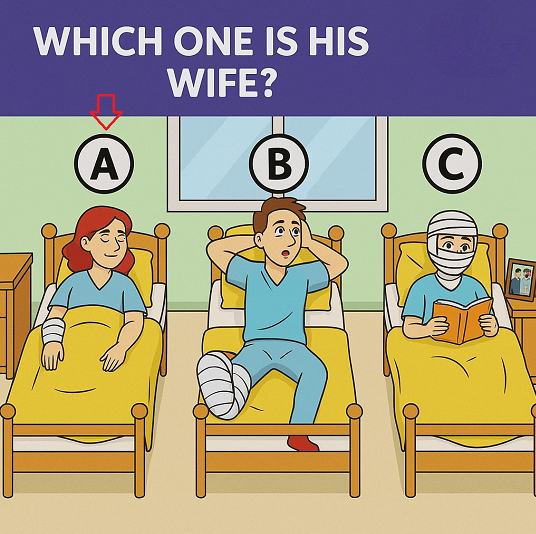If you’re a fan of brain teasers that test your logic, observation, and critical thinking, you’re in for a treat! At first glance, the image above shows a simple hospital room with three patients labeled A, B, and C. B is the man in the middle, and your challenge is to answer this deceptively simple question: Which one is his wife?
Sounds easy, right? Look again. There are clues hidden in plain sight, and your ability to pay attention to the details is key. So, take a moment, analyze the image carefully, and see if you can solve the mystery before scrolling down for the breakdown.
Ready? Let’s dive in.

Why We Get It Wrong: Common Traps in Visual Riddles
Riddles like this one often trip people up because we rely on our assumptions rather than what’s actually shown. Our brains are wired to jump to conclusions when faced with incomplete information, especially in familiar settings like a hospital scene.
Here are a few common mistakes readers make with this type of puzzle:
- Jumping to conclusions based on appearances: Many assume that the person who smiles at B (like patient A) must be his wife simply because they appear to be interacting.
- Ignoring background details: People often overlook small background elements like photos or objects that hold critical clues.
- Focusing on clothing or gender stereotypes: Some might assume C is female due to the bandages and build, which adds to the confusion.
This is exactly why puzzles like this sharpen your thinking. They force you to slow down, observe, and question everything.
Video : COOL BRAINY RIDDLES AND OPTICAL ILLUSIONS THAT’LL TRICK YOUR MIND! 😵
Step-by-Step Clue Analysis: Solving the Puzzle
Let’s break down the image, step by step, and look at the evidence logically.
1. Observe the setup:
We see three patients in adjacent beds — A, B, and C. All three are in hospital clothing. B is the person we’re focusing on. He has an injured leg and seems to be relaxed, gazing upward.
2. Look at patient A:
A is smiling and appears to be looking at B. She has red hair and an arm injury. Her body is turned slightly toward B, giving an impression of familiarity. Many might immediately jump to the conclusion that A is his wife just because of this visual interaction. But is that really enough?
Hold that thought.

3. Examine patient C carefully:
C is fully bandaged from head to toe, with only their eyes visible. This character is reading a book and seems calm and focused. Most viewers might assume this is a woman — likely because of size or posture — but that’s a dangerous assumption.
Now, here’s where it gets interesting.
4. Look closely at the nightstand beside patient C:
There’s a framed photo placed on the table next to C. This small but powerful clue tells us a lot. If you zoom in on that photo, you’ll notice something very telling — it’s a picture of two men.
If C had a wife, wouldn’t it make more sense to have a photo with a woman? Instead, the photo suggests that C is male and possibly in a relationship with another man or simply has a close male friend or brother — either way, it eliminates C as B’s wife.
Conclusion from this clue:
C is not a woman. C is a man.
5. Back to patient A:
Now that we’ve ruled out C, let’s return to A. She’s looking at B with a calm expression. There’s no additional object like a photo next to her bed, but the body language and proximity are natural. She’s injured, but alert and clearly paying attention to B. This subtle connection is the final piece of the puzzle.
So, who is B’s wife?
Answer: A is B’s wife.

Summary of Evidence:
- C is not a woman — the framed photo shows C is a man.
- A is the only patient giving visual attention to B.
- B seems relaxed, possibly because he’s lying next to someone he feels close to.
- The simplicity of A’s interaction with B is what makes her the correct answer.
Final Thoughts: Why These Puzzles Are So Powerful
The beauty of riddles like this lies in their simplicity. You don’t need advanced knowledge — just the ability to observe, interpret, and think critically. They challenge our assumptions and remind us that the answers aren’t always on the surface. It’s not just about what you see — it’s about how deeply you look.
These types of puzzles are great tools to strengthen your problem-solving abilities, sharpen your memory, and even improve your emotional intelligence by paying attention to visual cues and nonverbal communication.
Video : Can you spot The Fake Nurse?
Your Turn!
Now that you’ve solved the mystery (or read the explanation), we want to hear from you!
- Did you pick A, B, or C?
- What clues led you to your decision?
- Did you notice the photo on your own, or did it catch you by surprise?
Drop your answer in the comments and tag a friend to see if they can figure it out too. It’s always fun to see how differently people interpret the same image.
And don’t stop here! Keep training your brain with more logic puzzles, visual riddles, and interactive challenges. The more you practice, the sharper your mind becomes.
Stay curious, stay observant — and never stop looking twice.